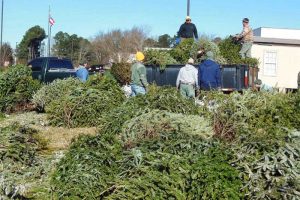This page may contain affiliate links. If you click and buy, we might get a small commission at no cost to you.
If you set up a live Christmas tree in your house for the holiday season, you may be wondering what to do with it after the season has ended. While pretty all decorated, Christmas trees can be large and seem like a hassle to get rid of. But, don’t worry we have you covered. Read on for a list of ideas on how to dispose of your Christmas tree, ranging from recycling your tree to getting creative with the branches.
Preparing for Christmas tree disposal
Before you dispose of your live Christmas tree with one of the ideas listed below, you have to first properly remove the tree from your home and prepare it for disposal. For starters, it’s best to remove your tree from your home before it completely dries out. The drier they are, the more they drop their needles and become fire hazards.
The common best practices for preparing your tree for disposal include removing all the ornaments, lights, and tinsel from the tree and disposing of them separately. Most of the disposal methods below will only take bare trees. Some methods may also require you to cut your tree. For example, you’ll need to cut them into smaller chunks to fit inside your yard-waste bin. When possible, it is also best to cut your tree into 4-foot portions to make curbside pickup easier.
If you have scattered needles in your house after you remove your tree, make sure to sweep them instead of using a vacuum. Needles can easily clog up and damage your vacuum cleaner. You’ll also want to check for water damage on your floor or carpet after removal. Clean up the area and steam carpets to prevent mold.
How to dispose of a Christmas tree
Here is a list of 7 ideas for disposing of your live Christmas tree after the holiday season has ended.
1. Schedule curbside pick-up
Most cities will offer curbside pick-up services for your Christmas tree. You’ll want to check the schedule of when this service is offered since it is typically only for the two weeks after Christmas. However, some areas will do pick-ups for the entire month of January.

Make sure to also double-check what are the requirements for pick-up. Most curbside pick-up services will require you to remove all organic materials or even cut your tree. Additionally, not all areas will take flocked trees, where the tree has been spray-painted white for a “wintery feel.” Typically flocked trees will end up in landfills instead of being recycled.
If you miss the scheduled pick-up dates, your city may allow you to place the tree in a yard waste container. However, you will have to find a way to cut it down to small sizes where it can fit.
2. Call a local organization
If not through your city, you can set up an appointment with some local nonprofits that are providing tree pick-up services in your area. They are usually offering this service as a fundraiser where your money will go to a good cause supporting their programs.
Organizations, such as boy scout troops, offer the services for a small donation of around $5. Sometimes local high schools will also have services where students will pick up your trees for a small donation.
You can also donate your tree to organizations engaging in wetland restoration efforts or wildlife preserves. They can typically use the trees in different habitats, such as in lakes to prevent curb erosion or to form fish habitats. It’s best not to just throw your tree into public water bodies, so let an experienced organization handle the habitat transformations.
3. Give it to a tree mulching program
Most communities now have a tree mulching program where the trees will be chipped and shredded to make mulch. The mulch can then be repurposed to be used in gardens, outdoor spaces, or playgrounds. Some local communities will offer the mulch back to residents for free to use in their gardens.
Try checking with your local department of public works to see if they offer this type of recycling program. Typically, the local hauler will notify you of the dates in your area that pick-up is available.
4. Drop it off at a recycling location
Most cities or counties will have drop-off locations that take Christmas trees. You can search online or in databases, such as Earth911, to find an available location near you. Sometimes drop-off places will be advertised in your local newspaper or on city government websites, especially if it’s a temporary pop-up location for specific dates after the holidays.

While some locations accept drop-offs for free, some yard waste facilities will ask you to pay a fee based on the weight of your tree. Typically, this will cost around or less than $5. Many yard waste facilities will also have special hours during January to compost trees, so make sure you don’t wait too long before deciding to dispose of your Christmas tree.
Examples of potential tree drop-off locations include:
- Drop off events at city parks
- Fire stations
- Recreation and parks locations
- Train station drop-off locations
5. Recycle the tree yourself
Instead of having your tree picked up or dropping it off at a recycling program, there are ways to remove the tree from your home and repurpose it in your backyard. Examples of what you can do with your tree include:
- Compost pile: Use thin branches to make a base for an outdoor compost pile. They’ll provide space for the airflow you need to compost.
- Protect perennials: You can cut long branches from your tree and lay them over your perennials in your garden. This can help prevent your plant from dying of frost.
- Create mulch: You can create your own mulch by using a tree chipper or gradually cut your tree into thin 2-inch pieces. These small snips can be tossed onto outdoor paths as a cheap method to mulch a pathway.
- Trunk repurposing: After trimming all the branches and needles off of the tree, you can repurpose the trunk as a garden bed edging or support for growing vining plants.
6. Get creative with your tree
Another way to recycle your tree at home is to get creative with the different ways you can repurpose the tree trunk or branches. For example, you can use your old Christmas tree for:
- Bird feeders: Place a few large branches or the entire tree in your back yard as an organic feeder by hanging pinecones with birdseed and peanut butter on the branches.
- Coasters: By cutting the tree trunk into one-inch disks you can make homemade coasters. Make sure to varnish the coasters before using them.
- Wall art: Using the branches of the tree you can bend them into creative wall art. You can also cut pieces of the tree and turn them into ornaments for next year’s holiday.
- Pond habitat: If you have a backyard pond, consider sinking pieces of your tree to create feeding areas and hiding places for fish.
7. Replant your tree
If you bought your tree with the roots intact, you can go ahead and replant your tree. This way it can be a beautiful addition to your outdoor space and ready for use in the next holiday season. Unfortunately, live Christmas trees without roots can’t be replanted.
How to dispose of an artificial Christmas tree
While the above ideas work well for a live Christmas tree, there are different things you have to take into consideration when disposing of an artificial Christmas tree. Artificial trees are made of a difficult-to-recycle plastic called polyvinyl chloride (PVC). They are meant to be used repeatedly over the years, and not for recycling. If you want to get rid of an artificial tree, consider:
- Taking it to your local landfill or a home improvement retailer
- Donating it to charitable organizations that collect trees for re-distribution
- Giving it to a local organization, such as nursing homes that can use them for their holidays
- Keeping it until October or November to give to thrift stores
- Scheduling a bulk-item pick up through your city



